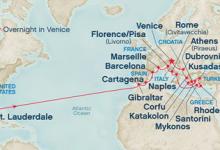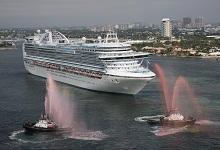Recently Viewed Cruises
- Ruby, Med & Greek Isles Grand Adventure ex Ft Lauderdale to VeniceAdd to favourites
- Caribbean, British Isles Passage ex Ft Lauderdale to SouthamptonAdd to favourites
- Emerald, Northern Europe Passage ex Ft Lauderdale to CopenhagenAdd to favourites
- Millennium, Transpacific Cruise ex Shanghai to SewardAdd to favourites
- Poesia, Ocean Voyage ex New York to DoverAdd to favourites
- Catch up on Cruising: Latest cruise news in bite size
- Royal Caribbean International raises the bar
- Classy Astor fills gap in market
- Oceanic Discoverer
- Ab Fab Oosterdam
- Frequently Asked Questions
-
Ruby, Med & Greek Isles Grand Adventure ex Ft Lauderdale to Venice
Nights 26 Ship Ruby Princess Star Rating 
Departs Ft Lauderdale (Pt Everglades), USA Sailing 2013: 28 Apr Ports of Call Ft Lauderdale (Pt Everglades), Gibraltar, Cartagena, Barcelona, Marseilles, Livorno, Rome (Civitavecchia), Naples More Santorini, Kusadasi, Mykonos, Athens (Piraeus) Greece, Katakolon, Corfu, Dubrovnik, Venice Please enquire about this cruise for pricing.
26 Night Cruise sailing from Ft Lauderdale to Venice aboard Ruby Princess.
Ruby Princess includes a dramatic piazza-style atrium featuring small-bite eateries and performing street entertainers. Passengers will also enjoy an array of dining venues including the signature Sabatini's Italian restaurant and the Crown Grill steak and seafood restaurant, plus a relaxing oasis just for adults called The Sanctuary. Ruby Princess will also offer the popular Movies Under the Stars, multiple entertainment options, Personal Choice Dining featuring traditional or Anytime seating, Lotus Spa with fitness center, an extensive children and teen's center, a wedding chapel and nearly 900 staterooms with private balconies.
Highlights of this cruise:
Ft Lauderdale
According to the popular 1960 beach movie, Fort Lauderdale is "where the boys are." The city's reputation as America's Spring Break capital, however, has been replaced with the more favorable image of a prime family tourist destination, attracting more than 10 million visitors annually. The most popular beach resort in Florida is even more rightly famed as the "Yachting Capital of the World," with more than 40,000 registered crafts calling its waters home. The city also prides itself on being the "Venice of America" with more than 300 miles of navigable waterways. Fort Lauderdale boasts world-class theaters, museums, sightseeing, and shopping.
The city sits 24 miles north of Miami and is named after a series of forts built by the United States during the second Seminole War. The forts took their name from Major William Lauderdale, who was the commander of the detachment of soldiers who built the first fort. Look hard and you might find remnants of three of them today. More people seem to be interested in taking a water tour aboard the "Carrie B."
Gibraltar
The Rock crouches over the sea like an ancient stone beast, looking Sphinx-like to Africa. Beneath the white cliffs of this natural fortress grows a profusion of palm, pine, and cypress. No fewer than 600 varieties of flowers thrive here, some not found anywhere else on Earth. Gibraltar's stunning setting is matched by its history - five countries have battled for 13 centuries to control the passage between the Atlantic and the Mediterranean. The result made for a cultural melting pot. Veiled Moroccan women in caftans and vacationing Englishmen and Spaniards stroll along the narrow, steep lanes. The locals revert to a liquid Spanish when talking among themselves. And visitors to a 15th-century cathedral pass through a blue-tiled courtyard, once part of a 13th-century mosque.
Helmeted bobbies, pillar-boxes and pubs make for a bit of Britain in the Mediterranean. Gibraltar is a fascinating place, from its caves and batteries to the Barbary apes gamboling on the slopes of the Rock.
Cartagena
Cartagena is an ancient port - the city served as Hannibal's Spanish headquarters during the 2nd Punic War with Rome. The city remained a major trading port under the Romans and the Moors. Today, Cartagena is Spain's principal naval establishment and the site of an annual international maritime festival. The city is also your gateway to the Costa Calida, a region that boasts some of Spain's mildest weather along with 175 miles of beaches.
Marseille
The largest port on the Mediterranean, Marseille is France's second largest city and a virtual melting pot of peoples and cultures. It is also a place of striking contrasts, from the fishing boats and pleasure craft of the picturesque Vieux Port to the modern Canebiere. Dominating the harbor is the infamous Chateau d'If, the rocky prison from which Alexandre Dumas' Count of Monte Cristo escaped. Marseille is also your gateway to Provence. Explore the countryside around Arles and Avignon, immortalized in the canvases of Van Gogh, Cezanne, Matisse and Picasso.
Rome
Your gateway to the Eternal City, Civitavecchia has served as Rome's seaport since the 13th century. The port has a long and venerable history. The emperor Trajan built a pleasure villa near the modern city, while Bernini and Michelangelo designed the harbor fortifications.
Yet the Eternal City eternally beckons. The ancient capital of the Western World and the center of Christianity for nearly 2,000 years, Rome provides an inexhaustible feast. Visit the ruins of the Forum, view the splendors of the Sistine Chapel, or climb the Spanish Steps, once the heart of Rome's Bohemian Quarter.
Rome has been a magnet luring the world's greatest artists, architects, and philosophers since the days of the Caesars.
Santorini
Did the catastrophic volcanic eruption that ravaged Santorini circa 1600 B.C. destroy Crete's ancient Minoan civilization - and give birth to the myth of Atlantis? In 1967, archaeologists on Santorini unearthed the remains of a Bronze Age city that may have been home to as many as 30,000 people. Whether the Lost Continent of Atlantis is rooted in myth or reality, an undisputed fact remains. The eruption created a caldera - and one of the most dramatic land and seascapes in the entire Mediterranean. On Santorini, whitewashed buildings cling to vertiginous cliffs that plunge to a turquoise sea. Part of the Cyclades Archipelago, the three-island group of Santorini, Thirasia and uninhabited Aspronisi present the traveler with unforgettable vistas.
The island has had a number of names throughout history - from Strongyle or "Round" to Thera in honor of an ancient hero. Santorini is more recent and stems from the island church dedicated to St. Irene - Santa Rini to foreign sailors.
Mykonos
Thanks to its proximity to the mainland, Mykonos was one of the first Greek islands to become an international travel destination. During the late '60s and early '70s, Mykonos was famed as a haunt for the rich. The island's nightlife - then and now - was a glittering whirl of colored lights, music, and parties. But there's another side to Mykonos - the neighboring island of Delos. In classical mythology, Delos was the birthplace of Apollo and his twin sister Artemis. Travelers to Delos can stroll among the island's vast ruins, which include three temples consecrated to the Sun God and the famed Lions Walk.
Mykonos town features hip boutiques, restaurants, jewelry stores, souvenirs, taverns and cafes. The island's famed windmills are found just south of the waterfront.
Athens
The past maintains a vibrant presence in the cradle of Western civilization. Atop the Acropolis, the serene Parthenon sails above the commotion of the modern city. The tragedies of Aeschylus, Sophocles, and Euripides were performed in the Theater of Dionysus at the foot of the Acropolis. On Pnyx Hill, citizens of a fledgling democracy gathered to cast their votes on Athens' destiny. Then there is the hustle and bustle of the modern city, a metropolis of 4.5 million that spreads out from the foot of Mt. Lycabettus and across the plain. Packed with busy shops and lively tavernas, modern Athens is a colorful counterpoint to classical Greece.
Piraeus is the port city for Athens and has been Athens' port of entry for over two millennia.
Corfu
The lush and verdant island of Corfu lies in the Ionian Sea, midway between Greece and Italy. The island has a long and colorful history. First colonized by the city-state of Corinth, Corfu has been ruled by the Romans, the Venetians, the French and the English. Corfu Town boasts fortresses bearing the insignia of the Venetian Republic, an esplanade lavishly planted by the French during the Napoleonic Wars, and an English cricket pitch. The island also offers some of the finest coastal scenery in the entire Mediterranean.
Corfu's old town is a mixture of the medieval and the modern. The Esplanade, planted with palms and eucalyptus by the French, leads to the English cricket pitch.
Venice
Rising from the waters of the Laguna Veneta, Venice has long - and rightly - been regarded as one of the world's most beautiful cities. Napoleon, who had an eye for acquisitions, once described St. Mark's Square as the finest drawing room in Europe. Certainly, no other site can quite match its superb campanile, Doge's Palace and recumbent lions. Just over two miles in length, the Grand Canal is lined with stunning buildings that reflect the city's unique heritage. Cruise through its winding canals on a gondola or watch the bronze Moors on the clock tower strike the passing hours as they have for 500 years - Venice is an unparalleled experience.
The city began life as a refuge from barbarian invasions. By the Crusades, Venice's dominion extended throughout the Adriatic and Mediterranean. The winged lion - symbol of St. Mark - flew over palaces and fortresses from Gibraltar to the Black Sea.







